Effect of Filler Alignment on Piezo-Resistive and Mechanical Properties of Carbon Nanotube Composites
Abstract
1. Introduction
2. Materials and Methods
2.1. Materials
2.2. Fabrication of MWCNT/PDMS Composite
2.3. Characterization
3. Results and Discussion
3.1. Morphology and Raman Spectroscopy Analysis
3.2. Mechanical Properties
3.3. Electrical Properties
3.4. Piezo-Resistive Properties
4. Conclusions
Author Contributions
Funding
Conflicts of Interest
References
- Chu, K.; Kim, D.; Sohn, Y.; Lee, S.; Moon, C.; Park, S. Electrical and Thermal Properties of Carbon-Nanotube Composite for Flexible Electric Heating-Unit Applications. IEEE Electron. Device Lett. 2013, 34, 668–670. [Google Scholar] [CrossRef]
- Chu, K.; Park, S.-H. Electrical heating behavior of flexible carbon nanotube composites with different aspect ratios. J. Ind. Eng. Chem. 2016, 35, 195–198. [Google Scholar] [CrossRef]
- Chu, K.; Yun, D.-J.; Kim, D.; Park, H.; Park, S.-H. Study of electric heating effects on carbon nanotube polymer composites. Org. Electron. 2014, 15, 2734–2741. [Google Scholar] [CrossRef]
- Gupta, P.; Sharan, S.; Roy, P.; Lahiri, D. Aligned carbon nanotube reinforced polymeric scaffolds with electrical cues for neural tissue regeneration. Carbon 2015, 95, 715–724. [Google Scholar] [CrossRef]
- Mikhalchan, A.; Gspann, T.; Windle, A. Aligned carbon nanotube–epoxy composites: The effect of nanotube organization on strength, stiffness, and toughness. J. Mater. Sci. 2016, 51, 10005–10025. [Google Scholar] [CrossRef]
- Sohn, Y.; Kim, D.E.; Park, S.T.; Lee, S.-E. Seamless Tube-Type Heater with Uniform Thickness and Temperature Distribution Based on Carbon Nanotubes Aligned by Circumferential Shearing. Materials 2019, 12, 3283. [Google Scholar] [CrossRef]
- Bauhofer, W.; Kovacs, J.Z. A review and analysis of electrical percolation in carbon nanotube polymer composites. Compos. Sci. Technol. 2009, 69, 1486–1498. [Google Scholar] [CrossRef]
- Ha, J.H.; Chu, K.; Park, S.H. Electrical Properties of the Carbon-Nanotube Composites Film Under Extreme Temperature Condition. J. Nanosci. Nanotechnol. 2019, 19, 1682–1685. [Google Scholar] [CrossRef]
- Li, A.; Bogdanovich, A.E.; Bradford, P.D. Aligned carbon nanotube sheet piezoresistive strain sensors. Smart Mater. Struct. 2015, 24, 095004. [Google Scholar] [CrossRef]
- Parmar, K.; Mahmoodi, M.; Park, C.; Park, S.S. Effect of CNT alignment on the strain sensing capability of carbon nanotube composites. Smart Mater. Struct. 2013, 22, 075006. [Google Scholar] [CrossRef]
- Gupta, P.; Rajput, M.; Singla, N.; Kumar, V.; Lahiri, D. Electric field and current assisted alignment of CNT inside polymer matrix and its effects on electrical and mechanical properties. Polymer 2016, 89, 119–127. [Google Scholar] [CrossRef]
- Ma, L.; Yang, W.; Wang, Y.; Chen, H.; Xing, Y.; Wang, J. Multi-dimensional strain sensor based on carbon nanotube film with aligned conductive networks. Compos. Sci. Technol. 2018, 165, 190–197. [Google Scholar] [CrossRef]
- Shintake, J.; Piskarev, E.; Jeong, S.H.; Floreano, D. Ultrastretchable Strain Sensors Using Carbon Black-Filled Elastomer Composites and Comparison of Capacitive Versus Resistive Sensors. Adv. Mater. Technol. 2018, 3, 1700284. [Google Scholar] [CrossRef]
- Wang, Y.; Wang, L.; Yang, T.; Li, X.; Zang, X.; Zhu, M.; Wang, K.; Wu, D.; Zhu, H. Wearable and Highly Sensitive Graphene Strain Sensors for Human Motion Monitoring. Adv. Funct. Mater. 2014, 24, 4666–4670. [Google Scholar] [CrossRef]
- Ha, J.-H.; Lee, S.-E.; Park, S.-H. Effect of Dispersion by Three-Roll Milling on Electrical Properties and Filler Length of Carbon Nanotube Composites. Materials 2019, 12, 3823. [Google Scholar] [CrossRef] [PubMed]
- Junyong, L.; Miao, L.; Bermak, A.; Yi-Kuen, L. Study of piezoresistance effect of carbon nanotube-PDMS composite materials for nanosensors. In Proceedings of the 2007 7th IEEE Conference on Nanotechnology (IEEE NANO), Hong Kong, China, 2–5 August 2007; pp. 1240–1243. [Google Scholar]
- Liu, S.; Tian, M.; Zhang, L.; Lu, Y.; Chan, T.W.; Ning, N. Tailoring dielectric properties of polymer composites by controlling alignment of carbon nanotubes. J. Mater. Sci. 2016, 51, 2616–2626. [Google Scholar] [CrossRef]
- Larijani, M.M.; Khamse, E.J.; Asadollahi, Z.; Asadi, M. Effect of aligned carbon nanotubes on electrical conductivity behaviour in polycarbonate matrix. Bull. Mater. Sci. 2012, 35, 305–311. [Google Scholar] [CrossRef]
- Lanticse, L.J.; Tanabe, Y.; Matsui, K.; Kaburagi, Y.; Suda, K.; Hoteida, M.; Endo, M.; Yasuda, E. Shear-induced preferential alignment of carbon nanotubes resulted in anisotropic electrical conductivity of polymer composites. Carbon 2006, 44, 3078–3086. [Google Scholar] [CrossRef]
- Khan, S.U.; Pothnis, J.R.; Kim, J.-K. Effects of carbon nanotube alignment on electrical and mechanical properties of epoxy nanocomposites. Compos. Part A Appl. Sci. Manuf. 2013, 49, 26–34. [Google Scholar] [CrossRef]
- Amani, A.; Hashemi, S.A.; Mousavi, S.M.; Pouya, H.; Vojood, A. Electric Field Induced Alignment of Carbon Nanotubes: Methodology and Outcomes. In Carbon Nanotubes-Recent Progress; IntechOpen: London, UK, 2018; pp. 71–88. [Google Scholar]
- Goh, G.L.; Agarwala, S.; Yeong, W.Y. Aerosol-Jet-Printed Preferentially Aligned Carbon Nanotube Twin-Lines for Printed Electronics. ACS Appl. Mater. Interfaces 2019, 11, 43719–43730. [Google Scholar] [CrossRef]
- Goh, G.L.; Saengchairat, N.; Agarwala, S.; Yeong, W.Y.; Tran, T. Sessile droplets containing carbon nanotubes: A study of evaporation dynamics and CNT alignment for printed electronics. Nanoscale 2019, 11, 10603–10614. [Google Scholar] [CrossRef] [PubMed]
- Herren, B.; Gu, T.; Tang, Q.; Saha, M.; Liu, Y. 3D Printing and Stretching Effects on Alignment Microstructure in PDMS/CNT Nanocomposites. In Proceedings of the ASME 2019 International Mechanical Engineering Congress and Exposition, Salt Lake City, UT, USA, 11–14 November 2019. [Google Scholar]
- Agarwala, S.; Goh, G.L.; Goh, G.D.; Dikshit, V.; Yeong, W.Y. Chapter 10—3D and 4D printing of polymer/CNTs-based conductive composites. In 3D and 4D Printing of Polymer Nanocomposite Materials; Sadasivuni, K.K., Deshmukh, K., Almaadeed, M.A., Eds.; Elsevier: Amsterdam, The Netherlands, 2020; pp. 297–324. [Google Scholar]
- Abbasi, S.; Carreau, P.J.; Derdouri, A. Flow induced orientation of multiwalled carbon nanotubes in polycarbonate nanocomposites: Rheology, conductivity and mechanical properties. Polymer 2010, 51, 922–935. [Google Scholar] [CrossRef]
- Abu Bakar, S.; Park, J. Alignment of multi-walled carbon nanotubes in a polyethylene matrix by extrusion shear flow: Mechanical properties enhancement. J. Compos. Mater. 2010, 45, 931–941. [Google Scholar] [CrossRef]
- Han, B.; Xue, X.; Xu, Y.; Zhao, Z.; Guo, E.; Liu, C.; Luo, L.; Hou, H. Preparation of carbon nanotube film with high alignment and elevated density. Carbon 2017, 122, 496–503. [Google Scholar] [CrossRef]
- Zhou, Z.; Wang, X.; Faraji, S.; Bradford, P.D.; Li, Q.; Zhu, Y. Mechanical and electrical properties of aligned carbon nanotube/carbon matrix composites. Carbon 2014, 75, 307–313. [Google Scholar] [CrossRef]
- Li, H.; Dai, X.; Zhao, L.; Li, B.; Wang, H.; Liang, C.; Fan, J. Microstructure and properties of carbon nanotubes-reinforced magnesium matrix composites fabricated via novel in situ synthesis process. J. Alloys Compd. 2019, 785, 146–155. [Google Scholar] [CrossRef]
- Paramsothy, M.; Chan, J.; Kwok, R.; Gupta, M. Addition of CNTs to enhance tensile/compressive response of magnesium alloy ZK60A. Compos. Part A Appl. Sci. Manuf. 2011, 42, 180–188. [Google Scholar] [CrossRef]
- Yu, Y.; Luo, Y.; Guo, A.; Yan, L.; Chun, O.; Jiang, K.; Li, Q.; Fan, S.; Wang, J. Flexible and Transparent Strain Sensors Based on Super-aligned Carbon Nanotube Films. Nanoscale 2017, 9, 6716–6723. [Google Scholar] [CrossRef]
- Gommans, H.H.; Alldredge, J.W.; Tashiro, H.; Park, J.; Magnuson, J.; Rinzler, A.G. Fibers of aligned single-walled carbon nanotubes: Polarized Raman spectroscopy. J. Appl. Phys. 2000, 88, 2509–2514. [Google Scholar] [CrossRef]
- Jin, L.; Chortos, A.; Lian, F.; Pop, E.; Linder, C.; Bao, Z.; Cai, W. Microstructural origin of resistance-strain hysteresis in carbon nanotube thin film conductors. Proc. Natl. Acad. Sci. USA 2018, 115, 1986–1991. [Google Scholar] [CrossRef]
- Duan, L.; Fu, S.; Deng, H.; Zhang, Q.; Wang, K.; Chen, F. The resistivity-strain behavior of conductive polymer composites: Stability and sensitivity. J. Mater. Chem. A 2014, 2, 17085–17098. [Google Scholar] [CrossRef]
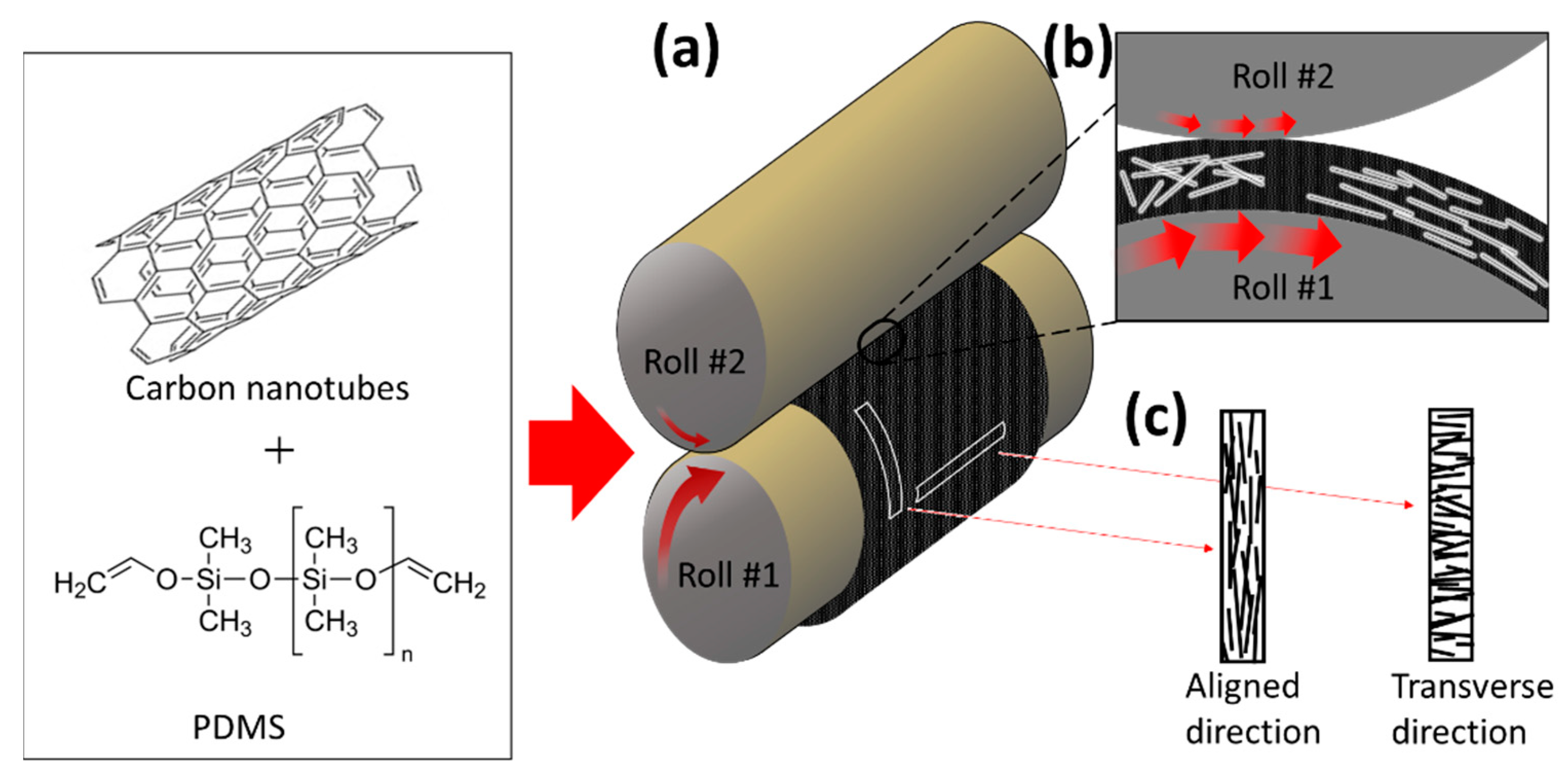
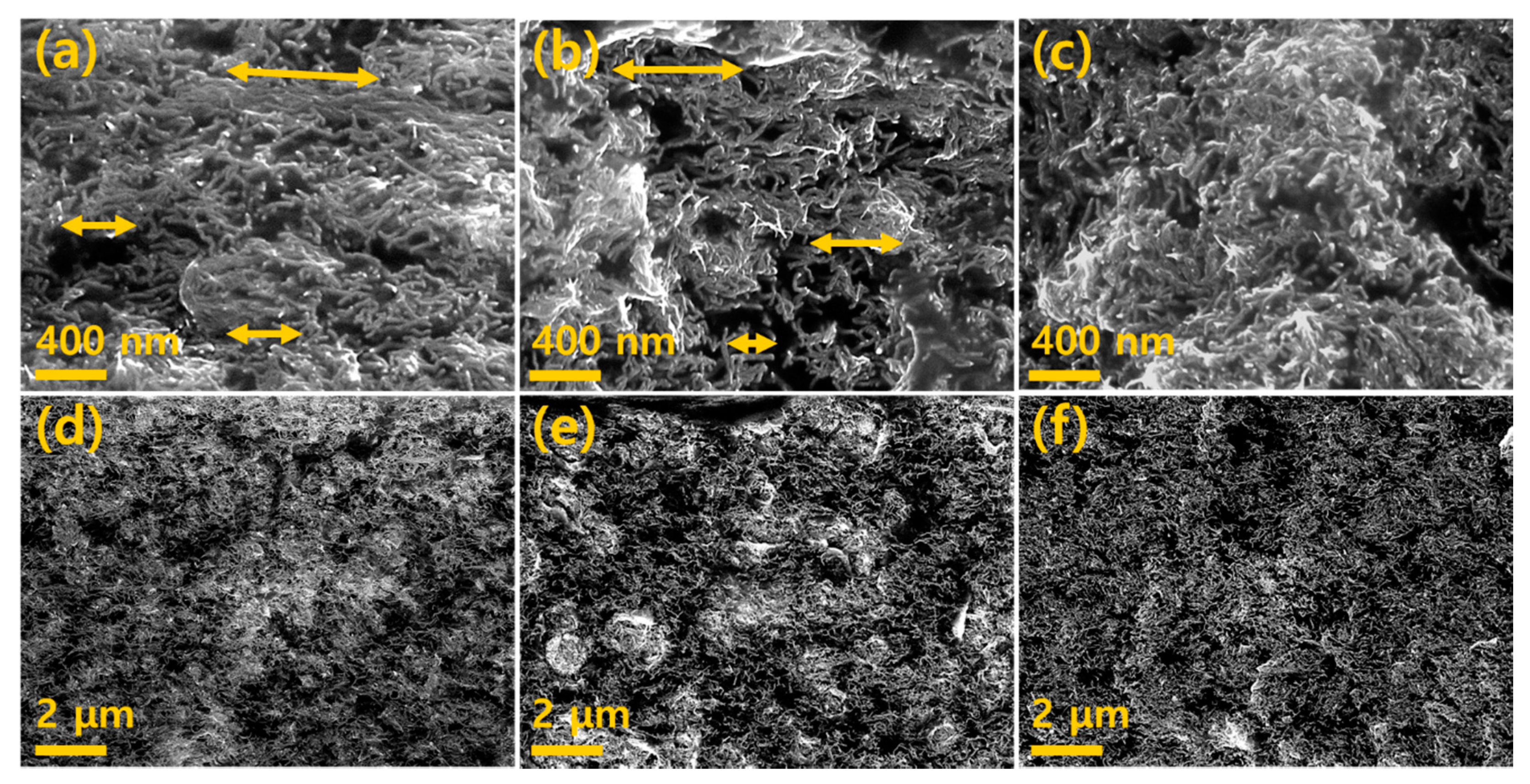

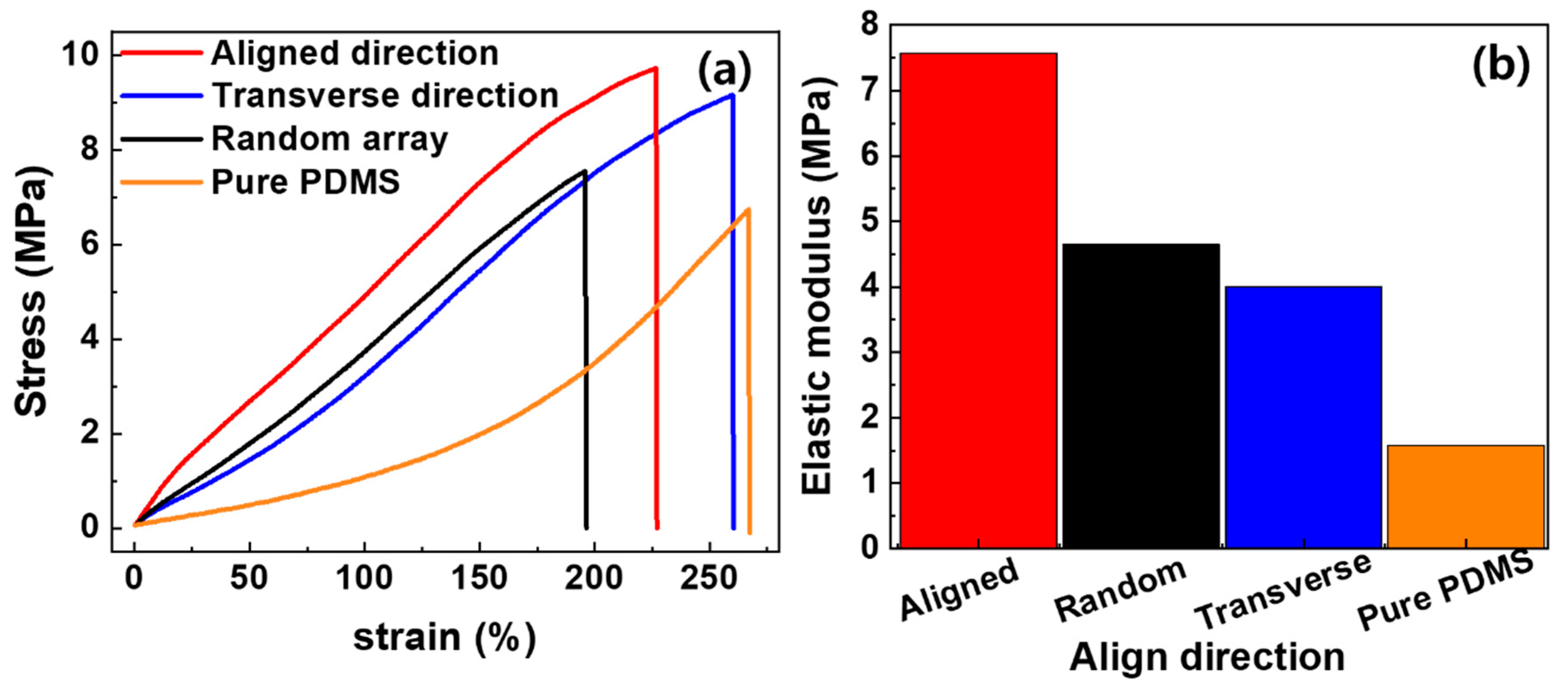
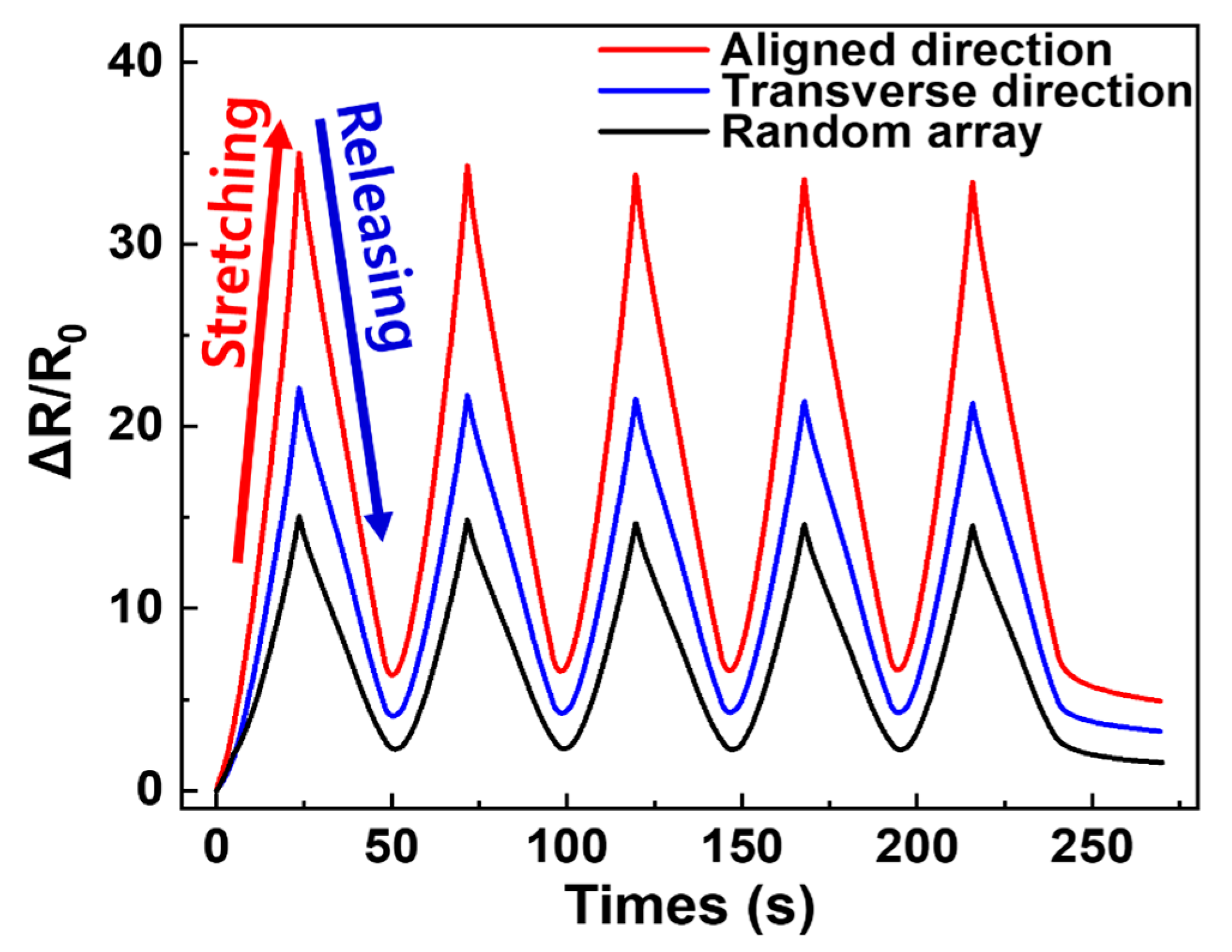
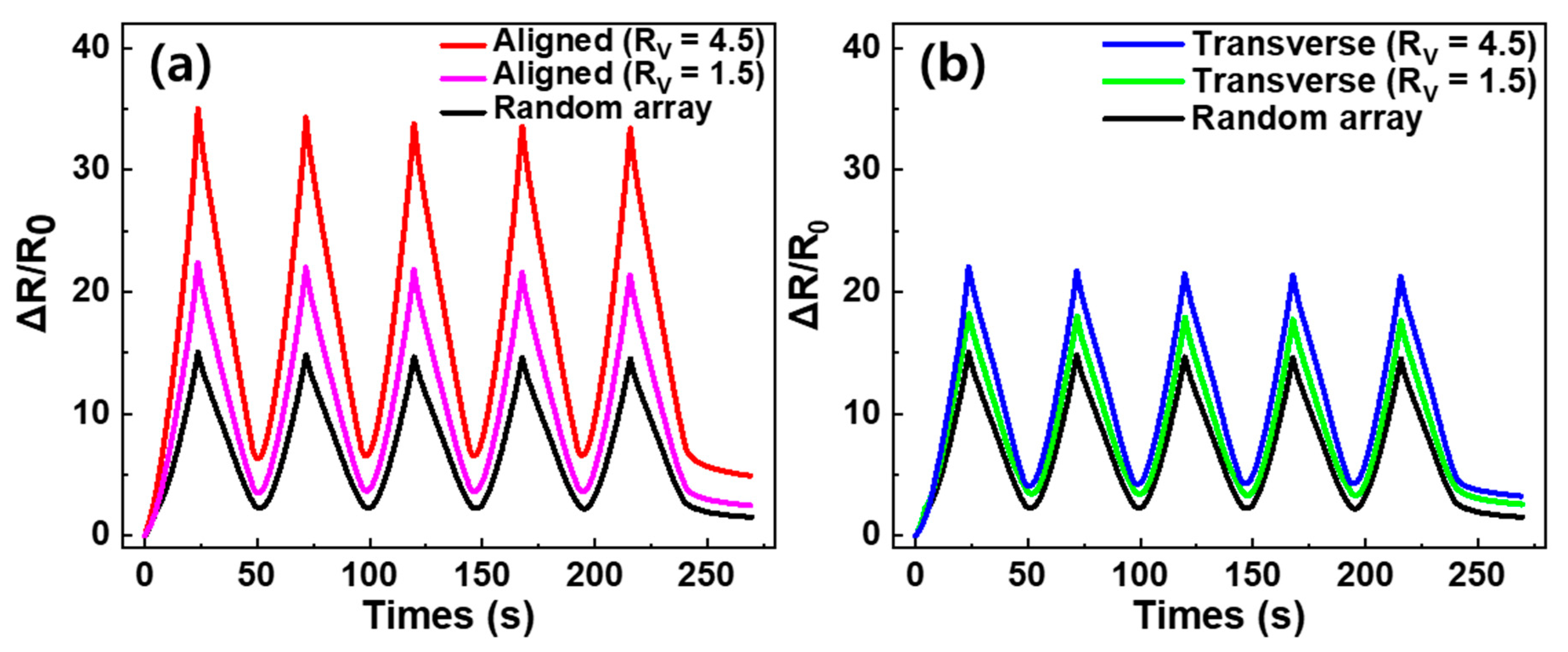
| Align Direction | RV (V1/V2) | Electrical Conductivity [S/m] | Tensile Strength [MPa] | Young’s Modulus [MPa] | Raman Intensity Ratio Parallel/Perpendicular | |
|---|---|---|---|---|---|---|
| GII/GT | DII/DT | |||||
| Aligned | 4.5 | 101 | 9.72 | 7.57 | 2.08 | 2.44 |
| 1.5 | 92 | 8.53 | 5.12 | 1.83 | 2.10 | |
| Transverse | 4.5 | 57 | 9.16 | 4.00 | - | - |
| 1.5 | 67 | 8.77 | 4.09 | - | - | |
| Random | - | 88 | 7.55 | 4.65 | 1.65 | 1.98 |
| Pure PDMS | - | - | 6.72 | 1.58 | - | - |
| Reference and Year | Align Direction | Electrical Conductivity (S/m) | Tensile Strength (MPa) | Young’s Modulus (MPa) | Resistance Change (%) | Fabrication Method | Type of Composite |
|---|---|---|---|---|---|---|---|
| Current study | Aligned direction | 101 (5 wt %) | 9.72 | 7.57 | 35.0 (0 to 10%) | Roll-to-roll mill, hot film-presser | 5 wt % MWCNT/PDMS composite |
| Transverse direction | 57 (5 wt %) | 9.16 | 4.00 | 21.9 (0 to 10%) | |||
| Random array | 88 (5 wt %) | 7.55 | 4.65 | 14.9 (0 to 10%) | hot film-presser | ||
| [10], 2013 | Aligned direction | R0 = 13.9 kΩ | - | - | ΔR/ΔL = 3.65 | Injection molding | 5 wt % MWCNT/poly-carbonate composite |
| Transverse direction | R0 = 39.9 kΩ | - | - | ΔR/ΔL = 6.5 | |||
| [21], 2018 | Aligned direction | 3 × 10−4 | - | 5500 | - | DC electrical fields applied | 0.5 wt % MWCNT/epoxy resin composite |
| Transverse direction | 9 × 10−5 | - | - | - | |||
| Random array | 6 × 10−5 | - | 3900 | - | |||
| [11], 2016 | Aligned direction | 8 × 10−5 | 34 | 1200 | - | DC electrical fields applied | MWCNT/poly vinylidene fluoride composite |
| Transverse direction | 1.5 × 10−5 | 39 | 1210 | - | |||
| Random array | 1.8 × 10−5 | 26 | 950 | - | |||
| [4], 2015 | Aligned direction | 5.25 × 10−3 | 72 | 1680 | - | DC electrical fields applied | 0.5 wt % MWCNT/chito-san composite |
| Transverse direction | 4.57 × 10−8 | 50 | 1620 | - | |||
| Random array | 4.77 × 10−3 | 68 | 1640 | - | |||
| [12], 2018 | Aligned direction | R0 = 4.96 kΩ | 9.5 | 4.7 | 9 | CNT film on the PDMS | |
| Transverse direction | R0 = 69.6 kΩ | 7.5 | 4.4 | 1 | |||
© 2020 by the authors. Licensee MDPI, Basel, Switzerland. This article is an open access article distributed under the terms and conditions of the Creative Commons Attribution (CC BY) license (http://creativecommons.org/licenses/by/4.0/).
Share and Cite
Kim, H.; Hong, S.-K.; Ryu, J.-K.; Park, S.-H. Effect of Filler Alignment on Piezo-Resistive and Mechanical Properties of Carbon Nanotube Composites. Materials 2020, 13, 2598. https://doi.org/10.3390/ma13112598
Kim H, Hong S-K, Ryu J-K, Park S-H. Effect of Filler Alignment on Piezo-Resistive and Mechanical Properties of Carbon Nanotube Composites. Materials. 2020; 13(11):2598. https://doi.org/10.3390/ma13112598
Chicago/Turabian StyleKim, Hyunwoo, Soon-Kook Hong, Jae-Kwan Ryu, and Sung-Hoon Park. 2020. "Effect of Filler Alignment on Piezo-Resistive and Mechanical Properties of Carbon Nanotube Composites" Materials 13, no. 11: 2598. https://doi.org/10.3390/ma13112598
APA StyleKim, H., Hong, S.-K., Ryu, J.-K., & Park, S.-H. (2020). Effect of Filler Alignment on Piezo-Resistive and Mechanical Properties of Carbon Nanotube Composites. Materials, 13(11), 2598. https://doi.org/10.3390/ma13112598





